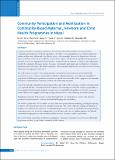Please use this identifier to cite or link to this item:
https://hdl.handle.net/20.500.14356/1982Full metadata record
| DC Field | Value | Language |
|---|---|---|
| dc.contributor.author | KC, N P | - |
| dc.contributor.author | KC, A | - |
| dc.contributor.author | Sharma, N | - |
| dc.contributor.author | Malla, H | - |
| dc.contributor.author | Thapa, N | - |
| dc.contributor.author | Aryal, K | - |
| dc.contributor.author | Vitrakoti, R | - |
| dc.contributor.author | Bhandari, R M | - |
| dc.date.accessioned | 2023-06-04T10:06:07Z | - |
| dc.date.available | 2023-06-04T10:06:07Z | - |
| dc.date.issued | 2011 | - |
| dc.identifier.citation | KCN. P., KCA., SharmaN., MallaH., ThapaN., AryalK., VitrakotiR., & BhandariR. M. (2011). Community Participation and Mobilization in Community-Based Maternal, Newborn and Child Health Programmes in Nepal. Journal of Nepal Health Research Council. https://doi.org/10.33314/jnhrc.v0i0.283 | en_US |
| dc.identifier.issn | Print ISSN: 1727-5482; Online ISSN: 1999-6217 | - |
| dc.identifier.uri | http://103.69.126.140:8080/handle/20.500.14356/1982 | - |
| dc.description | Special Issue Articles | en_US |
| dc.description.abstract | Abstract A number of studies on community mobilization for maternal and newborn health have demonstrated that community participation is of profound importance in the delivery of community based survival interventions for mother, newborn and children and a cost effective way to reduce mortality. However, the lessons learnt from the efficacy trials have not been tested within the health systems. Nepal is well known for its public health programmes and wide successes in campaign based interventions as a result of active involvement of volunteers and organizations based in the community. This paper analyzes the degree of community participation and mobilization in community-based maternal, newborn and child health programmes and its potential implication in acceleration towards achieving Millennium Development Goals 4 and 5. The study is based on analysis of the existing national community based maternal, neonatal and child health programmes in terms of degree of community mobilization and participation for ownership and sustainability of programmes. Furthermore, a qualitative assessment was carried out to assess the level of engagement of community structures in community based maternal, newborn and child health programme. None of the national community based maternal, newborn and child health programmes used the community action cycle approach and there was minimal level of involvement of community networks. The mother’s groups had been least engaged in identifying and solving the maternal, newborn and child health problems and Female community health volunteer were engaged in delivering messages at household level and not through the mother’s groups. Though the Community Action Cycle was studied in Nepal and it was found effective to achieve the objectives, getting its lessons into practice to design community health programs were lacking. The mother’s groups need to be revitalized to ensure their active participation in identifying, analyzing and agreeing on steps to solve the problems related to maternal, neonatal and child health so that care seeking and utilization of health services will be further enhanced. The national strategies need to explore the possibilities of incorporating the community action cycle frame into its programmes, test the frame and ensure its implementation in the National community based programs in order to improve health outcomes of mother, newborn and children. Keywords: Nepal, community mobilization, participation, community based maternal, newborn and child health programmes, mother’s group, female community health volunteer. | en_US |
| dc.language.iso | en | en_US |
| dc.publisher | Nepal Health Research Council | en_US |
| dc.relation.ispartofseries | October;283 | - |
| dc.subject | Community mobilization | en_US |
| dc.subject | Participation | en_US |
| dc.subject | Community based maternal | en_US |
| dc.subject | Newborn and child health programmes | en_US |
| dc.subject | Mother’s group | en_US |
| dc.subject | Female community health volunteer | en_US |
| dc.title | Community Participation and Mobilization in Community-Based Maternal, Newborn and Child Health Programmes in Nepal | en_US |
| dc.type | Journal Article | en_US |
| local.journal.category | Special Issue Articles | - |
| Appears in Collections: | Vol 9 No 2 Issue 19 October 2011 | |
Files in This Item:
| File | Description | Size | Format | |
|---|---|---|---|---|
| 283-Article Text-281-1-10-20130822.pdf | Fulltext Download | 272.45 kB | Adobe PDF |  View/Open |
Items in DSpace are protected by copyright, with all rights reserved, unless otherwise indicated.
